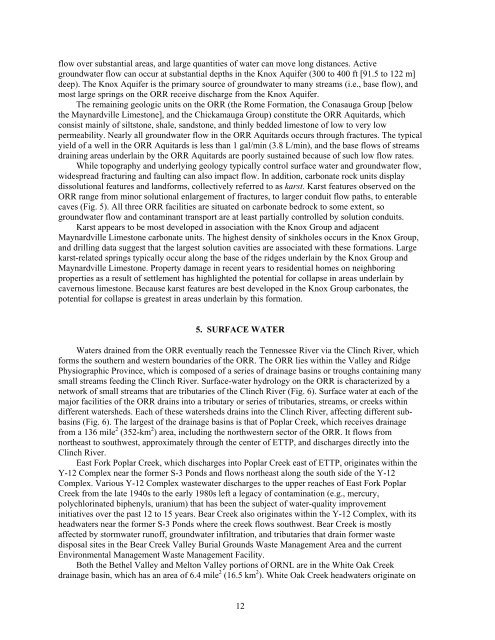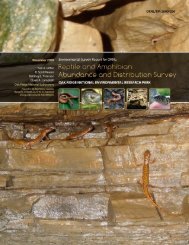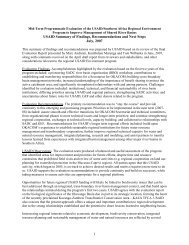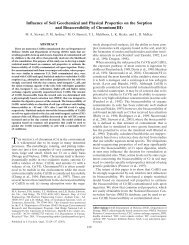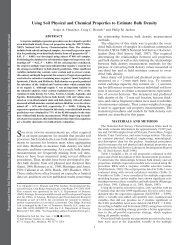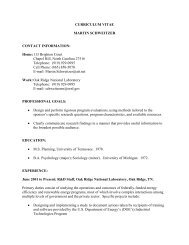oak ridge reservation physical characteristics and natural resources
oak ridge reservation physical characteristics and natural resources
oak ridge reservation physical characteristics and natural resources
You also want an ePaper? Increase the reach of your titles
YUMPU automatically turns print PDFs into web optimized ePapers that Google loves.
flow over substantial areas, <strong>and</strong> large quantities of water can move long distances. Active<br />
groundwater flow can occur at substantial depths in the Knox Aquifer (300 to 400 ft [91.5 to 122 m]<br />
deep). The Knox Aquifer is the primary source of groundwater to many streams (i.e., base flow), <strong>and</strong><br />
most large springs on the ORR receive discharge from the Knox Aquifer.<br />
The remaining geologic units on the ORR (the Rome Formation, the Conasauga Group [below<br />
the Maynardville Limestone], <strong>and</strong> the Chickamauga Group) constitute the ORR Aquitards, which<br />
consist mainly of siltstone, shale, s<strong>and</strong>stone, <strong>and</strong> thinly bedded limestone of low to very low<br />
permeability. Nearly all groundwater flow in the ORR Aquitards occurs through fractures. The typical<br />
yield of a well in the ORR Aquitards is less than 1 gal/min (3.8 L/min), <strong>and</strong> the base flows of streams<br />
draining areas underlain by the ORR Aquitards are poorly sustained because of such low flow rates.<br />
While topography <strong>and</strong> underlying geology typically control surface water <strong>and</strong> groundwater flow,<br />
widespread fracturing <strong>and</strong> faulting can also impact flow. In addition, carbonate rock units display<br />
dissolutional features <strong>and</strong> l<strong>and</strong>forms, collectively referred to as karst. Karst features observed on the<br />
ORR range from minor solutional enlargement of fractures, to larger conduit flow paths, to enterable<br />
caves (Fig. 5). All three ORR facilities are situated on carbonate bedrock to some extent, so<br />
groundwater flow <strong>and</strong> contaminant transport are at least partially controlled by solution conduits.<br />
Karst appears to be most developed in association with the Knox Group <strong>and</strong> adjacent<br />
Maynardville Limestone carbonate units. The highest density of sinkholes occurs in the Knox Group,<br />
<strong>and</strong> drilling data suggest that the largest solution cavities are associated with these formations. Large<br />
karst-related springs typically occur along the base of the <strong>ridge</strong>s underlain by the Knox Group <strong>and</strong><br />
Maynardville Limestone. Property damage in recent years to residential homes on neighboring<br />
properties as a result of settlement has highlighted the potential for collapse in areas underlain by<br />
cavernous limestone. Because karst features are best developed in the Knox Group carbonates, the<br />
potential for collapse is greatest in areas underlain by this formation.<br />
5. SURFACE WATER<br />
Waters drained from the ORR eventually reach the Tennessee River via the Clinch River, which<br />
forms the southern <strong>and</strong> western boundaries of the ORR. The ORR lies within the Valley <strong>and</strong> Ridge<br />
Physiographic Province, which is composed of a series of drainage basins or troughs containing many<br />
small streams feeding the Clinch River. Surface-water hydrology on the ORR is characterized by a<br />
network of small streams that are tributaries of the Clinch River (Fig. 6). Surface water at each of the<br />
major facilities of the ORR drains into a tributary or series of tributaries, streams, or creeks within<br />
different watersheds. Each of these watersheds drains into the Clinch River, affecting different subbasins<br />
(Fig. 6). The largest of the drainage basins is that of Poplar Creek, which receives drainage<br />
from a 136 mile 2 (352-km 2 ) area, including the northwestern sector of the ORR. It flows from<br />
northeast to southwest, approximately through the center of ETTP, <strong>and</strong> discharges directly into the<br />
Clinch River.<br />
East Fork Poplar Creek, which discharges into Poplar Creek east of ETTP, originates within the<br />
Y-12 Complex near the former S-3 Ponds <strong>and</strong> flows northeast along the south side of the Y-12<br />
Complex. Various Y-12 Complex wastewater discharges to the upper reaches of East Fork Poplar<br />
Creek from the late 1940s to the early 1980s left a legacy of contamination (e.g., mercury,<br />
polychlorinated biphenyls, uranium) that has been the subject of water-quality improvement<br />
initiatives over the past 12 to 15 years. Bear Creek also originates within the Y-12 Complex, with its<br />
headwaters near the former S-3 Ponds where the creek flows southwest. Bear Creek is mostly<br />
affected by stormwater runoff, groundwater infiltration, <strong>and</strong> tributaries that drain former waste<br />
disposal sites in the Bear Creek Valley Burial Grounds Waste Management Area <strong>and</strong> the current<br />
Environmental Management Waste Management Facility.<br />
Both the Bethel Valley <strong>and</strong> Melton Valley portions of ORNL are in the White Oak Creek<br />
drainage basin, which has an area of 6.4 mile 2 (16.5 km 2 ). White Oak Creek headwaters originate on<br />
12


